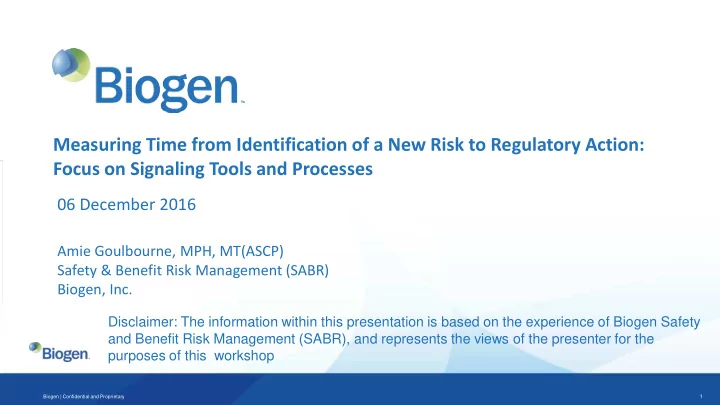

Measuring Time from Identification of a New Risk to Regulatory Action: Focus on Signaling Tools and Processes 06 December 2016 Amie Goulbourne, MPH, MT(ASCP) Safety & Benefit Risk Management (SABR) Biogen, Inc. Disclaimer: The information within this presentation is based on the experience of Biogen Safety and Benefit Risk Management (SABR), and represents the views of the presenter for the purposes of this workshop Biogen | Confidential and Proprietary 1
Time from Identification of a New Risk to Regulatory Action Speed (Time) ≠ Quality Speed & quality of results need to be balanced Communication to Prescribers & Patients Faster time may not increase impact of regulatory actions if Regulatory Quality of data/ communications is critical quality of data or communication Action for giving prescribers ability to make is poor informed decisions Quantity may not add to the Collecting & Analysing data take time benefit/risk assessment Lessons are learned by all parties as more data is generated and reviewed. Process is iterative Both time & quality need to be considered when measuring the impact of PV processes Overview| Example: Tysabri | Data Evaluation | Regulatory Action | Summary Biogen | Confidential and Proprietary 2
Example Time & Quality Components: Tysabri & PML 2010: PML Database; Data 2005:3 PML Cases, off Quality Improvements as market 2006: Returned to marketed; more data received 2016: Algorithm updated Educational Programs / in EU and refined to Restricted access in some regions Dec 2010 Three Risk Factors : provide further guidance Time on treatment • CDS provided rate of risk as 3 on risk factors • Prior Immunosuppression cases 1/1,000 treated patients • Presence of Anti-JCV Antibodies (95% CI: 0.2-2.8) 2005 2006 2008 2009 2010 2012 2016 2009: 2008: 2012: Risk Algorithm ~5 PML ~20 PML available that cases cases characterizes risks for prescribers Overview | Example: Tysabri | Data Evaluation | Regulatory Action | Summary Biogen | Confidential and Proprietary 3
2016 Tysabri & PML Balance Between Speed & Quality Initial Labeling Text 2006 3 cases 1/1,000 treated patients (95% CI: 0.2-2.8) 10 year process of reviewing data as received As data collected, applied learnings to improve data collection and analysis Data quality improved with Education of prescribers, patients, etc. Different types of data required with multiple experts reviewing Multiple reviews and discussions with Regulators globally Physician Information & Management Guidelines Overview | Example: Tysabri | Data Evaluation | Regulatory Action | Summary Biogen | Confidential and Proprietary 4
Safety Data Evaluation & Signal Identification Possible Solutions Challenges for Signal Detection Focus on most meaningful data Assessment of initial cases and rely on experience to limited Safety Data Quality of post-marketing data improve data quality Use Statistical and Visualization is often poor Significant efforts collecting data tools to improve efficiency and exclude noise that may not be meaningful Use technology to support data Decision making based on collection and analysis medical judgment Clarify roles / responsibilities regarding decision making SIGNAL Desired Impact : Faster signal detection leads to faster risk assessment Improved quality of safety data increases speed and accuracy Processes support clear decisions making & medical judgment Overview| Signal Identification | Data Evaluation | Regulatory Action | Summary Biogen | Confidential and Proprietary 5
Stage 1: Examples of Tools Visualizations: Providing easier ways to quickly identify trends and rule out noise Example: Risk assessment with Tableau Overview| Signal Identification | Data Evaluation | Regulatory Action | Summary Biogen | Confidential and Proprietary 6
Risk Assessment & Recommendations for Action Risk assessment to determine actions as quickly as possible High quality of data essential for accurate medical judgment RISK Often risk assessment is performed on minimal data, therefore initial assessments may be limited Alternate data sources and analyses provide further understanding of risk – including epidemiology, study data, statistical approaches Processes need to be simple and clear on decision making Ideal to complete one assessment for all regions, differences in requirements can delay or impede assessments Overview| Signal Identification| Data Evaluation | Regulatory Action | Summary Biogen | Confidential and Proprietary 7
Lessons Learned Data collection quality improved over time, as MAH, HCPs and Regulators learn from experience and educational outreach. More HCP training may be beneficial Explore many sources of data, such as laboratory data, epidemiology, clinical studies, large data collection systems (i.e., claims data) may improve quality and reduce time Technology supporting data collection & analysis, such as visualizations, statistics, etc. may reduce detection and analysis time Medical judgment is always required. Clear processes for decision making, including roles / responsibilities, and appropriate expertise, not just clinical, but also public health are critical Overview| Signal Identification| Data Evaluation | Regulatory Action | Summary Biogen | Confidential and Proprietary 8
Thank you & Questions Acknowledgements Nathan Nyein Monica Mehta Sandra Richman Patricia Valencia Jeffrey Philip Douglas Clark Achint Kumar Akash Panigrahi Simon Bennet Biogen | Confidential and Proprietary 9
Recommend
More recommend